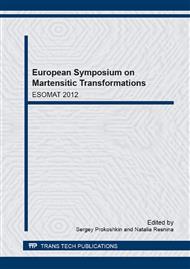[1]
R.C. Garvie, R.H. Hannink and R.T. Pascoe, Ceramic steel?, Nature 258 (1975) 703-704.
DOI: 10.1038/258703a0
Google Scholar
[2]
T.K. Gupta, F.F. Lange and J.H. Bechtold, Effect of Stress-Induced Phase Transformation on the Properties of Polycrystalline Zirconia Containing Metastable Tetragonal Phase, J. Mater. Sci. 13 (1978) 1464-1470.
DOI: 10.1007/bf00553200
Google Scholar
[3]
K. Kobayashi, H. Kuwajima and M. Masaki, Phase Change and Mechanical Properties of ZrO2-Y2O3 Solid-Electrolyte after Ageing, Solid State Ionics 3/4 (1981) 489-493.
DOI: 10.1016/0167-2738(81)90138-7
Google Scholar
[4]
H. Tsubakino, Isothermal Tetragonal-to-Monoclinic Phase Transformation in a Zirconia–Yttria System, Mater. Trans. 46 (2005) 1443-1451.
DOI: 10.2320/matertrans.46.1443
Google Scholar
[5]
S. Lawson, Environmental Degradation of Zirconia Ceramics, J. Eur. Ceram. Soc. 15 (1995) 485-502.
Google Scholar
[6]
S. Ramesh, Review of Ageing Behaviour of Yttria-Tetragonal Zirconia Polycrystals (Y-TZP): Part 1, Experimental Observations, J. Ind. Tech., 7 (1998) 1-29.
Google Scholar
[7]
F.F. Lange, G. L. Dunlop and B. I. Davis, Degradation during aging of transformation- toughened ZrO2-Y2O3 materials at 250°C, J. Am. Ceram. Soc. 69 (1986) 237-240.
DOI: 10.1111/j.1151-2916.1986.tb07415.x
Google Scholar
[8]
J. Chevalier, B. Cales , J.M. Drouin, Low-temperature aging of Y-TZP ceramics. J Am Ceram Soc. 82 (1999) 2150-2154.
DOI: 10.1111/j.1151-2916.1999.tb02055.x
Google Scholar
[9]
R.C. Garvie and P.S. Nicholson, Phase analysis in zirconia system, J. Am. Ceram. Soc. 55 (1972) 303- 305.
Google Scholar
[10]
F. F. Lange, Transformation toughening. 1 Size effects associated with the thermodynamics of constrained transformations, J. Mater. Sci. 17 (1982) 225–234.
DOI: 10.1007/bf00809057
Google Scholar
[11]
J.K. Lee and H. Kim, Microstructural development on the isothermal phase transformation during aging at 250℃ in 2Y-TZP Ceramics. J. Mater. Sci., 29 (1994) 136-140.
DOI: 10.1007/bf00356584
Google Scholar
[12]
J. Chevalier, L. Gemillardw, A.V. Virkar, D. R. Clarke, The Tetragonal-Monoclinic Transformation in Zirconia: Lessons Learned and Future Trends, J. Am. Ceram. Soc., 92 (2009) 1901–(1920).
DOI: 10.1111/j.1551-2916.2009.03278.x
Google Scholar
[13]
R. M. McMeeking and A. G. Evans, Mechanics of transformation-toughening in brittle Materials, J. Am. Ceram. Soc., 65 (1982) 242–246.
Google Scholar
[14]
S. Deville and J. Chevalier, Martensitic relief observation by atomic force microscopy in yttria-stabilized zirconia, J. Am. Ceram. Soc. 86 (2003) 2225–2227.
DOI: 10.1111/j.1151-2916.2003.tb03639.x
Google Scholar
[15]
M. Kelly and L. R. F. Rose, The martensitic transformation in ceramics-Its role in transformation toughening, Prog. Mater. Sci., 47 (2002), 463-557.
DOI: 10.1016/s0079-6425(00)00005-0
Google Scholar


